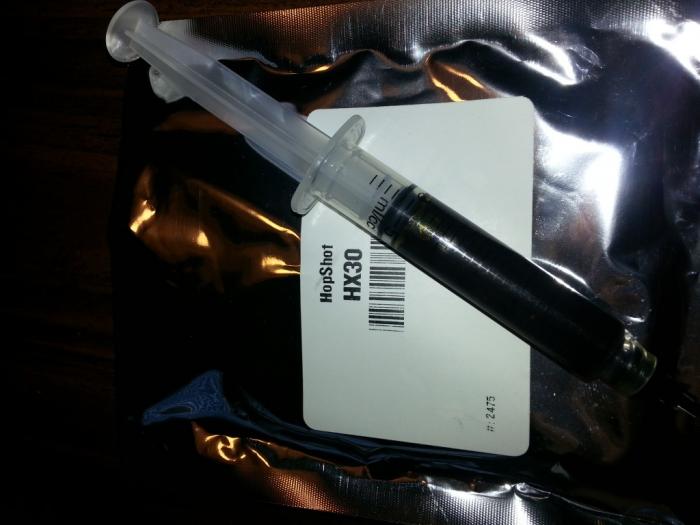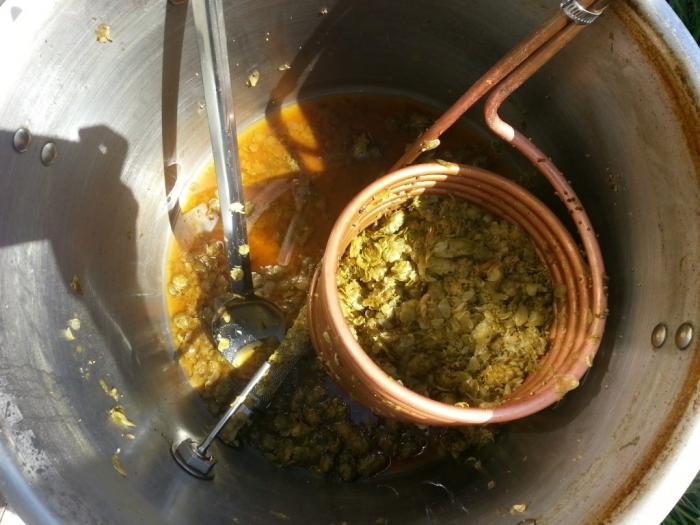Thanks for the recipe. I brewed a modified version of V4 scaled for my system and anticipated losses. I subbed out Crisp MO for the base and carabelge for the caramalt because the LHBS doesn't carry any British crystal malts. I am using all leaf hops (besides the hopshots) and didn't have any Amarillo on hand so I subbed Cascade there.
Type: All Grain
Date: 10/5/2013
Batch Size (fermenter): 6.00 gal
Brewer: RPK
Boil Size: 9.16 gal
Boil Time: 90 min
Target Brewhouse Efficiency: 70.00 %
Final Bottling Volume: 5.0 gal
Mash Schedule: 149F (75m), ramp and hold at 161F (15m), mashout 168F
Batch sparged.
Est Original Gravity: 1.074 SG
Measured Original Gravity: 1.073 SG (6 gallons)
Fermentation: 62F
Yeast: Green Mountains Ale (Conan) (Yeast Geek #001)
Ingredients
Amt Name Type # %/IBU
13 lbs 8.0 oz Maris Otter (Crisp) (4.0 SRM) Grain 1 83.1 %
1 lbs Carabelge (Weyermann) (17.0 SRM) Grain 2 6.2 %
1 lbs Wheat, Torrified (1.7 SRM) Grain 3 6.2 %
12.0 oz Sugar, Table (Sucrose) (1.0 SRM) Sugar 4 4.6 %
10 mL Hop Shot [2x] - Boil 90.0 min Hop 5 92.3 IBUs
1.00 oz Simcoe [13.00 %] - Boil 5.0 min Hop 6 6.0 IBUs
0.50 oz Apollo [19.50 %] - Boil 5.0 min Hop 7 4.5 IBUs
2.00 oz Simcoe [13.00 %] - Boil 0.0 min Hop 8 0.0 IBUs
1.00 oz Columbus (Tomahawk) [14.00 %] - Boil 0.0 min Hop 9 0.0 IBUs
1.00 oz Cascade [5.50 %] - Aroma Steep 30.0 min Hop 10 0.0 IBUs
1.00 oz Columbus (Tomahawk) [14.00 %] - Aroma Steep 30.0 min Hop 11 0.0 IBUs
1.00 oz Simcoe [13.00 %] - Aroma Steep 30.0 min Hop 12 0.0 IBUs
0.50 oz Apollo [19.50 %] - Aroma Steep 30.0 min Hop 13 0.0 IBUs
0.50 oz Centennial [10.00 %] - Aroma Steep 30.0 min Hop 14 0.0 IBUs
1.00 oz Simcoe [13.00 %] - Dry Hop 7.0 Days Hop 16 0.0 IBUs
0.50 oz Cascade [5.50 %] - Dry Hop 7.0 Days Hop 17 0.0 IBUs
0.50 oz Centennial [10.00 %] - Dry Hop 7.0 Days Hop 18 0.0 IBUs
0.50 oz Columbus (Tomahawk) [14.00 %] - Dry Hop 7.0 Days Hop 19 0.0 IBUs
0.25 oz Apollo [19.50 %] - Dry Hop 7.0 Days Hop 20 0.0 IBUs
1.00 oz Simcoe [13.00 %] - Dry Hop 4.0 Days Hop 21 0.0 IBUs
0.50 oz Cascade [5.50 %] - Dry Hop 4.0 Days Hop 22 0.0 IBUs
0.50 oz Centennial [10.00 %] - Dry Hop 4.0 Days Hop 23 0.0 IBUs
0.50 oz Columbus (Tomahawk) [14.00 %] - Dry Hop 4.0 Days Hop 24 0.0 IBUs
0.25 oz Apollo [19.50 %] - Dry Hop 4.0 Days Hop 25 0.0 IBUs
Here's a few pictures of the hop additions. I portioned out the dry hops and vacuum sealed them for later.
After draining the kettle, the leaf hops had soaked up a lot of wort so I piled most of them in the immersion chiller and gave them some gentle pressing (improvised hop press).
This is fermenting right along but I was wondering how others have added the dry hop additions. Are you guys adding the first dry hop to the primary and then racking onto the second dry hop after a week or just adding all to the primary over time?







